
Introduction
Government policies play a crucial role in advancing smart building adoption, promoting sustainability, energy efficiency, and technological advancements in the building sector. This article provides an overview of the significance of government policies in driving the adoption of smart buildings.
Historical Background
The concept of smart buildings has evolved over time, and government policies have played a pivotal role in their development. This section explores the historical background of smart buildings and highlights the influence of government initiatives and programs in supporting their adoption.
Key Concepts and Definitions
To understand the impact of government policies on smart building adoption, it is essential to define key terms such as smart buildings, government policies, energy efficiency, and sustainability. This section also explores the benefits and objectives of government policies in promoting the adoption of smart buildings.
Overview of Government Policies and Regulations
Various government policies and regulations have been implemented to promote the adoption of smart buildings. This section provides an overview of these policies, analyzes their impact on technology adoption, and presents case studies of successful policy implementation and their outcomes.
Identification of Key Stakeholders
Effective policy implementation requires collaboration and partnerships between government agencies, private sector organizations, and industry associations. This section discusses the roles and responsibilities of key stakeholders and presents case studies showcasing successful stakeholder engagement and collaboration.
Evaluation of Economic and Environmental Benefits
Government policies aimed at promoting smart building adoption yield significant economic and environmental benefits. This section analyzes the cost savings, energy efficiency improvements, and reduction in greenhouse gas emissions resulting from these policies. It also provides an overview of relevant studies and research findings, along with illustrative case studies.
Case Studies
To delve deeper into the impact of government policies, this section presents two case studies. Case study 1 focuses on the policies implemented in country X and their impact on smart building adoption. Case study 2 highlights a successful collaboration between government, private sector, and industry associations in country Y, analyzing outcomes, achievements, and the replicability of the collaboration model.
Current Trends and Developments
This section provides an overview of recent trends and developments in government policies related to smart building adoption. It also discusses technological advancements and innovations driving the adoption of smart building technologies, as well as recent research findings or studies on the impact of government policies.
Challenges and Controversies
Implementing government policies for smart building adoption can pose challenges. This section identifies and discusses these challenges, along with controversies or differing viewpoints surrounding government intervention in the building sector. Additionally, potential solutions or approaches to address these challenges and controversies are analyzed.
Future Outlook
Speculating on the future direction of government policies, this section considers how they will further advance smart building adoption. It also discusses emerging technologies or trends that may shape the future of smart buildings, along with potential policy changes or innovations required to promote their adoption.
Conclusion
In conclusion, government policies play a vital role in driving smart building adoption, promoting sustainability, energy efficiency, and technological advancements. This article highlights the significance of government policies and emphasizes the need for further research and action in the field.